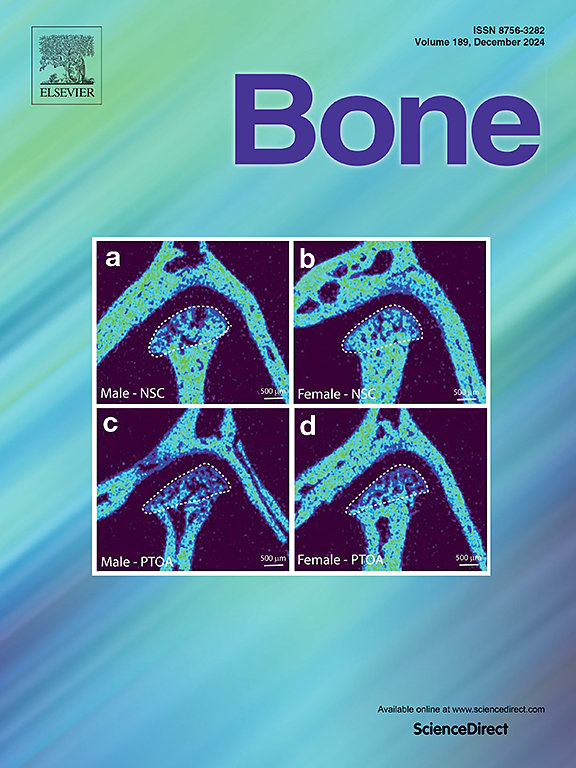Comparison of the bone remodeling in the midpalatal suture during maxillary expansion between young and middle-aged mice
IF 3.6
2区 医学
Q2 ENDOCRINOLOGY & METABOLISM
引用次数: 0
Abstract
Maxillary expansion is a common orthodontic procedure for treating maxillary transverse deficiency. However, the cell responses to mechanical force may vary across different age groups, suggesting the need for age-specific treatment protocols. To compare the age-related responses to the mechanical force, we examined the 6-week- and 12-month-old mice undergoing maxillary expansion with 0.012-in. stainless steel orthodontic wire bonded to the maxillary first and second molars (25 g force). Mice were euthanized on days 0, 3, 7, and 14 for analysis. MicroCT analysis, tartrate-resistant acid phosphatase (TRAP) stain, and immunofluorescence/immunohistochemistry stain using antibodies to RUNX2, alkaline phosphatase (ALP), Gli1 and Ki67 along with the TUNEL assay, were conducted to evaluate suture width, osteoclast activity, new bone formation and mesenchymal stem cell (MSC) proliferation and apoptosis. Both 6-week- and 12-month-old mice exhibited successful midpalatal suture opening, but young mice demonstrated earlier and more intense osteoclast activity, along with higher expression of RUNX2 and ALP. Young mice also exhibited a higher percentage of Gli1+Ki67+ immunopositive cells, while middle-aged mice showed a higher percentage of Gli1+TUNEL+ positive cells on day 3 after maxillary expansion. Our findings suggest that aging negatively impacts mechanical force-induced bone remodeling by reducing osteoclastogenesis, osteogenesis, and MSC proliferation while increasing MSC apoptosis.
中青年小鼠上颌扩张时中腭缝合线骨重塑的比较
上颌扩张是治疗上颌横向缺陷的常用正畸方法。然而,细胞对机械力的反应可能在不同的年龄组中有所不同,这表明需要针对年龄的治疗方案。为了比较年龄对机械力的反应,我们对6周龄和12月龄的小鼠进行了上颌扩张0.012英寸的实验。不锈钢正畸丝粘接在上颌第一和第二磨牙上(25g力)。小鼠分别于第0、3、7、14天实施安乐死进行分析。使用RUNX2、碱性磷酸酶(ALP)、Gli1和Ki67抗体进行微ct分析、抗酒石酸酸性磷酸酶(TRAP)染色、免疫荧光/免疫组织化学染色以及TUNEL检测,评估缝线宽度、破骨细胞活性、新骨形成和间充质干细胞(MSC)增殖和凋亡。6周龄和12月龄小鼠均能成功打开中腭缝合线,但幼龄小鼠破骨细胞活性更早、更强,RUNX2和ALP的表达也更高。年轻小鼠的Gli1+Ki67+免疫阳性细胞比例较高,而中年小鼠在上颌扩张后第3天的Gli1+TUNEL+阳性细胞比例较高。我们的研究结果表明,衰老通过减少破骨细胞生成、成骨和MSC增殖而增加MSC凋亡,对机械力诱导的骨重塑产生负面影响。
本文章由计算机程序翻译,如有差异,请以英文原文为准。
求助全文
约1分钟内获得全文
求助全文
来源期刊

Bone
医学-内分泌学与代谢
CiteScore
8.90
自引率
4.90%
发文量
264
审稿时长
30 days
期刊介绍:
BONE is an interdisciplinary forum for the rapid publication of original articles and reviews on basic, translational, and clinical aspects of bone and mineral metabolism. The Journal also encourages submissions related to interactions of bone with other organ systems, including cartilage, endocrine, muscle, fat, neural, vascular, gastrointestinal, hematopoietic, and immune systems. Particular attention is placed on the application of experimental studies to clinical practice.
 求助内容:
求助内容: 应助结果提醒方式:
应助结果提醒方式:


